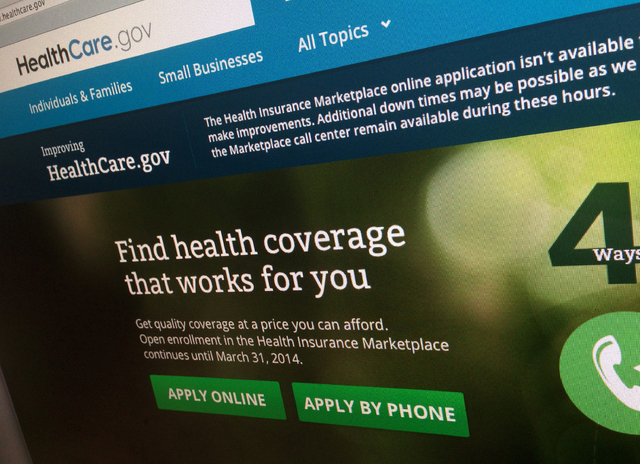Obamacare Explained: Hispanics lag in health insurance sign-ups
Fresh statistics on Medicaid enrollments don’t improve the outlook for Hispanic enrollment in health coverage.
When we last looked in April at Nevada’s share of Hispanic insurance sign-ups under the Affordable Care Act, enrollments for the demographic trended well below hopes and expectations. Just 17.8 percent of the group had bought private plans through the state’s Nevada Health Link exchange, even though Hispanics make up 34 percent of the local population and 43 percent of Nevada’s uninsured.
Observers weren’t too concerned, though, because they said they hadn’t seen a breakdown of Medicaid applications, where they expected Hispanics to show up in fuller force.
Now, it looks as if that hasn’t happened, either.
Statistics from the Welfare and Supportive Services Division, which runs Medicaid, show March’s caseload was 34.9 percent Hispanic. That was on pace with the group’s share of the local population, but down from 36.2 percent in March 2013.
Miki Allard, a division spokeswoman, said it appears that Hispanic sign-ups have “grown proportionately to other communities.”
But Andres Ramirez, president of local navigator firm Ramirez Group, said the figures disappoint.
“For the most part, Hispanics enrolled on par with other populations. However, that would mean that overall, we did not enroll as many Hispanics as originally planned,” he said. “If you aggregate these numbers with the published (exchange qualified health plan) enrollment numbers, then we need to do better about enrolling more Hispanics.”
Ramirez noted that it is up to enrollees to identify their ethnic group, so it’s possible some Hispanics or the people who enrolled them didn’t cite race on applications.
Still, Hispanic sign-ups are “definitely something that we need to evaluate,” Ramirez said.
■ Officials with the Silver State Health Insurance Exchange may say they have high enrollment hopes for the remainder of 2014 and early 2015, but they are using conservative sign-up numbers to help with budgeting in 2015. And that will significantly push up a membership charge designed to fund the agency starting in January, when federal start-up grants end.
The exchange board decided April 30 that the per-member-per-month fee insurers pay will increase to $13 for medical coverage, and $13.83 for combined medical-dental plans. The current rate is $4.95 for medical-only plans, and $5.31 for bundled medical-dental policies.
The fee is spiking because the exchange downgraded its expectations for enrollment by the end of 2014.
The board weighed per-member-per-month fees based on enrollments of 60,000, 100,000 and 150,000. When it launched last fall, the target was 118,000.
The fewer members the exchange has, the more it must charge in per-member-per-month fees. At 60,000, the flat medical rate is $13, but at 100,000 members, that fee would have fallen to $11.68. With 150,000 enrollees, it would have dropped to $9.84.
Paid enrollments are around 34,000 halfway through a special enrollment period that ends May 30. Board members decided to peg projections for year’s end at 60,000. The next open enrollment session starts Nov. 15.
At $13 a month, the fee will raise $9.36 million in 2015, Nevada Insurance Commissioner Scott Kipper told the board. That would cover the exchange’s $6.33 million in fixed costs such as office leases and salaries, and leave $3 million extra to add to marketing efforts and funding for enrollment facilitators and navigators.
Kipper also noted that Nevada’s $13 per-member-per-month fee would be 3.4 percent of the average premium, still below the 3.5 percent the federally run exchange charges.
The per-member-per-month fee is built into monthly premiums, so consumers will not get an extra bill or pay out of pocket for it.
■ A reader who withheld her name wants to know whether she can do anything about a federal tax credit she said is based on the wrong income. When she signed up for exchange-based coverage, someone told her she and her husband had to use their 2012 income tax return to determine eligibility. So that’s the income the couple’s subsidy is based on. The problem is, their household income has dropped by half since 2012. She is looking for options.
We contacted insurance broker Lydia Boske of Nevada West Business Insurance for guidance.
She suggested our reader should first call Nevada Health Link, file a complaint and ask the exchange to help with a correction because her premium tax credit was calculated using the wrong modified adjusted gross income. If a navigator recommended using 2012 income, the exchange should know that, too.
Boske said she didn’t understand why anyone would recommend using 2012 income, when the standard was to use a consumer’s best guess on 2014 income.
“There are so many inconsistencies that have occurred for consumers throughout this enrollment process that Nevada Health Link should be able to review any consumer concern or complaint,” Boske said. “When someone is enrolled on the exchange, their income can change at any time in 2014, and it’s the consumer’s responsibility to contact (Nevada Health Link) and let them know about their change in income.”
It might also help to reach out to an insurance broker for assistance. A consumer can appoint a broker at any time during enrollment by going back to log-in and putting the agent’s national producer’s number on the account. It won’t affect the navigator who helped with enrollment.
Contact Jennifer Robison at jrobison@reviewjournal.com or 702-380-4512. Follow @J_Robison1 on Twitter.


















